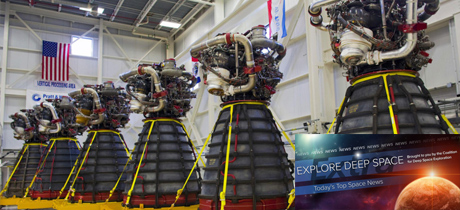In Today’s Deep Space Extra… The water that once flowed on Mars may have been absorbed by the planet’s crust billions of years ago and not drifted into space as previously thought. NASA’s Juno mission helps researchers analyze Jupiter’s auroras.
Human Space Exploration
Aerojet not concerned about any changes to Artemis program
Coalition Members in the News – Aerojet Rocketdyne, Lockheed Martin, Northrop Grumman
SpaceNews.com (3/17): Aerojet Rocketdyne doesn’t expect any potential changes to the Artemis program to have much of an effect on its business supplying engines for NASA’s SLS rocket. While initial flights of the SLS will use RS-25 engines originally flown on the space shuttle, the company won a contract last year to produce 18 new engines for later missions. Speaking at the J.P. Morgan Industrials Conference this week, Aerojet CFO Dan Boehle said the company’s work on the new engines would not be affected by delays to the planned 2024 lunar landing with the Artemis III mission.
ISS crew once again uses tea leaves to locate air leak in Russian module Zvezda
Sputnik News of Russia (3/16): Cosmonauts aboard the International Space Station (ISS) are again on the search for small leaks in the ISS’s Russian segment Zvezda service module. First noted in September 2019, two leaks were sealed earlier this month. The cosmonauts are using the motion of floating tea leaves in Zvezda to track the small sources. (Editor’s note: Sputnik News is a Russian owned news source).
Space Science
Mars might be hiding most of its old water underground, scientists say
The Verge (3/16): Published in the journal Science and presented at a virtual session of the annual Lunar and Planetary Science Conference on Tuesday, a new research effort counters the long-held assumption that large reserves of water that once flowed over Mars simply drifted into space, leaving behind an environment now cold and desert-like. Led by Caltech researchers, the findings from a string of NASA Mars orbiters, landers and rovers suggests the ample water on Mars was absorbed by the Martian soil.
Jupiter’s ‘dawn storm’ auroras are surprisingly Earth-like
Science Daily (3/16): Material erupting from Jupiter’s large moon Io is responsible for intensely bright auroras that surround Jupiter’s poles, according to a study led by researchers from the University of Liege. Data from NASA’s Juno mission made the new analysis possible. Before Juno, observations of Jovian ultraviolet auroras had offered only side views, hiding everything happening on the nightside of the planet.
A Titan mission could refuel on site and return a sample to Earth
Universetoday.com (3/16): A Titan Sample Return Using In-Situ Propellants is a NASA concept design to mine samples of Saturn’s moon Titan for return to Earth. The sample return vehicle was presented this year as part of the NASA Innovative Advanced Concepts (NIAC) program and would accompany the Dragonfly mission to Saturn’s moon Titan. The mission is scheduled to launch in 2027 and reach Titan by 2036. The In-Situ sample return mission would extract methane rocket propellant from Titan’s atmosphere as a means of launching back to Earth.
Other News
U.S. Space Force would support commercial services to remove orbital debris
SpaceNews.com (3/16): In an interview with the Foreign Policy Research Institute, Vice Chief of Space Operations of the U.S. Space Force Gen. David Thompson endorsed the prospect of contracting with commercial providers to remove orbital debris from orbit. The capability is still nascent; Japan-based company Astroscale plans to launch a debris-removal mission later this week.
China to construct commercial spaceport to support booming space industry
SpaceNews.com (3/16): With a growth in domestic commercial space activities underway, China plans to develop a commercial space port as part of the country’s new five-year plan. The premise is to meet an anticipated growing demand for space launch services. The proposed location has not been revealed.

